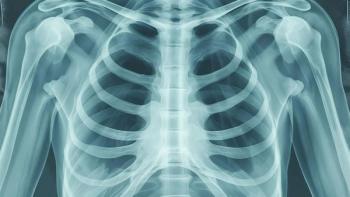
Immunotherapy Side Effects Could Mean Treatment Is Working in Non-Small Cell Lung Cancer
Key Takeaways
- Autoimmune skin toxicities in NSCLC patients correlate with improved response to anti-PD-1 immunotherapy, enhancing overall and progression-free survival.
- Shared T-cell antigens between lung tumors and skin suggest T cells attack both, causing skin toxicities, indicating a positive therapy response.
Autoimmune skin toxicities in patients with non-small cell lung cancer mean patients may respond better to immune checkpoint inhibitors.
Autoimmune side effects are associated with response to immunotherapy in patients with non-small cell lung cancer (NSCLC), according to studying findings published in JAMA Oncology.
“We could show that patients that experience skin toxicity are more likely to respond to immunotherapy with so-called
In a study designed to evaluate response to treatment, overall survival, progression-free survival and development of autoimmune toxic effects, researchers in Switzerland examined 73 patients with NSCLC who received either Opdivo (nivolumab) or Keytruda (pembrolizumab), two different types of anti-PD-1 treatment.
Patients — who were a mean age of 68.1 years and mostly men (60%) – were recruited from four different cancer centers over a two-year period. Lung tumor and skin samples were collected from patients, as well as peripheral blood mononuclear cells, which can be used to help study pathology and biology. Patient follow-up was completed after one year.
The researchers saw that 25 patients developed autoimmune
“Patients who responded to therapy were more than five times more likely to have experienced autoimmune skin toxic effects compared with those who did not respond, a finding that is in
line with results of several studies, suggesting that autoimmune adverse effects are associated with response to therapy,” the researchers wrote.
Autoimmune skin toxic effects appear as rashes or lesions on the skin that can either look like scaly plaques — like those seen in patients with psoriasis — or diffuse reddish-like rashes, Flatz explained.
In addition, the researchers identified nine T-cell antigens shared between tumor tissue and skin. T cells are one of the most important cells of our immune system for fighting cancer, Flatz noted. “We found that there are antigens that are expressed both in the lung tumor tissue and the skin (shared antigens),” he said. “The T cells therefore attack both the tumor cells and cells in the skin, causing skin toxic effects. In cancer research it is important to know which antigens are recognized by tumor-killing T cells, so the finding of these nine antigens was an important step forward.”
Although checkpoint inhibitors have improved survival and quality of life for patients with NSCLC, Flatz explained that only a subset of patients respond to the therapy — something that isn’t fully understood, and researchers hope to uncover the reason. “We believe that patients experiencing toxicities will be good responders to therapy, so in many cases these toxicities can be seen as a good sign and are clinically manageable,” he added “However, toxicities during therapy can occur in any organ in the body (not only the skin), and some of them, for example, in the heart, are dangerous and patients have to stop therapy.”
Flatz hopes to continue working to better understand the relationship between toxicity and response to therapy. “We hope that our findings will help to identify patients that are more likely to benefit from the therapy and those that are more likely to experience toxic effects,” he said.




